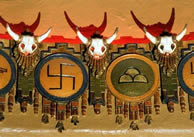Swastikas

The KiMo was designed and built in 1927 using the style and designs that were very common to several Native American cultures in the American southwest at that time.
Now on the National Register of Historic Places, the design elements of the KiMo Theatre are preserved for their original cultural significance.
Although today the swastika can evoke negative emotions, the KiMo invites visitors to remember that the original meaning of this ancient sacred symbol is one of life and prosperity.
Information about the Swastika Symbol
From Collector's Guide:
"One of the oldest symbols made by humans, the swastika dates back some 6,000 years to rock and cave paintings. Scholars generally agree it originated in India. With the emergence of the Sanskrit language came the term 'swastika', a combination of 'su', or good, and 'asti', to be; in other words, well-being."
From Wikipedia:
"The swastika was a widely used Native American symbol. It was used by many southwestern tribes, most notably the Navajo. Among different tribes the swastika carried various meanings. To the Hopi it represented the wandering Hopi clans; to the Navajo it represented a whirling log ( tsil no'oli' ), a sacred image representing a legend that was used in healing rituals.
"The history of the swastika goes back to the origins of the Eurasian Continent. The swastika is an important symbol in Hinduism and Buddhism, among others, and was also used in Native American and Jewish faiths prior to World War II. By the early twentieth century it was regarded worldwide as symbol of good luck and auspiciousness."
